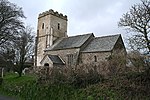Brightley Priory
1133 establishments in England1141 disestablishments in EnglandChristian monasteries established in the 12th centuryCistercian monasteries in EnglandMonasteries in Devon ... and 2 more
Religious organizations established in the 1130sRuins in Devon
Brightley Priory was founded in 1133 as a Cistercian monastery. It was built in 1136 and was situated about two miles north of Okehampton in Devon and was abandoned by the monks after only 5 years on their removal to a nearby site which became Forde Abbey.
Excerpt from the Wikipedia article Brightley Priory (License: CC BY-SA 3.0, Authors).Brightley Priory
Brightley Road, West Devon Okehampton Hamlets
Geographical coordinates (GPS) Address Nearby Places Show on map
Geographical coordinates (GPS)
| Latitude | Longitude |
|---|---|
| N 50.7586 ° | E -3.9883 ° |
Address
Brightley Road
Brightley Road
EX20 1RR West Devon, Okehampton Hamlets
England, United Kingdom
Open on Google Maps









